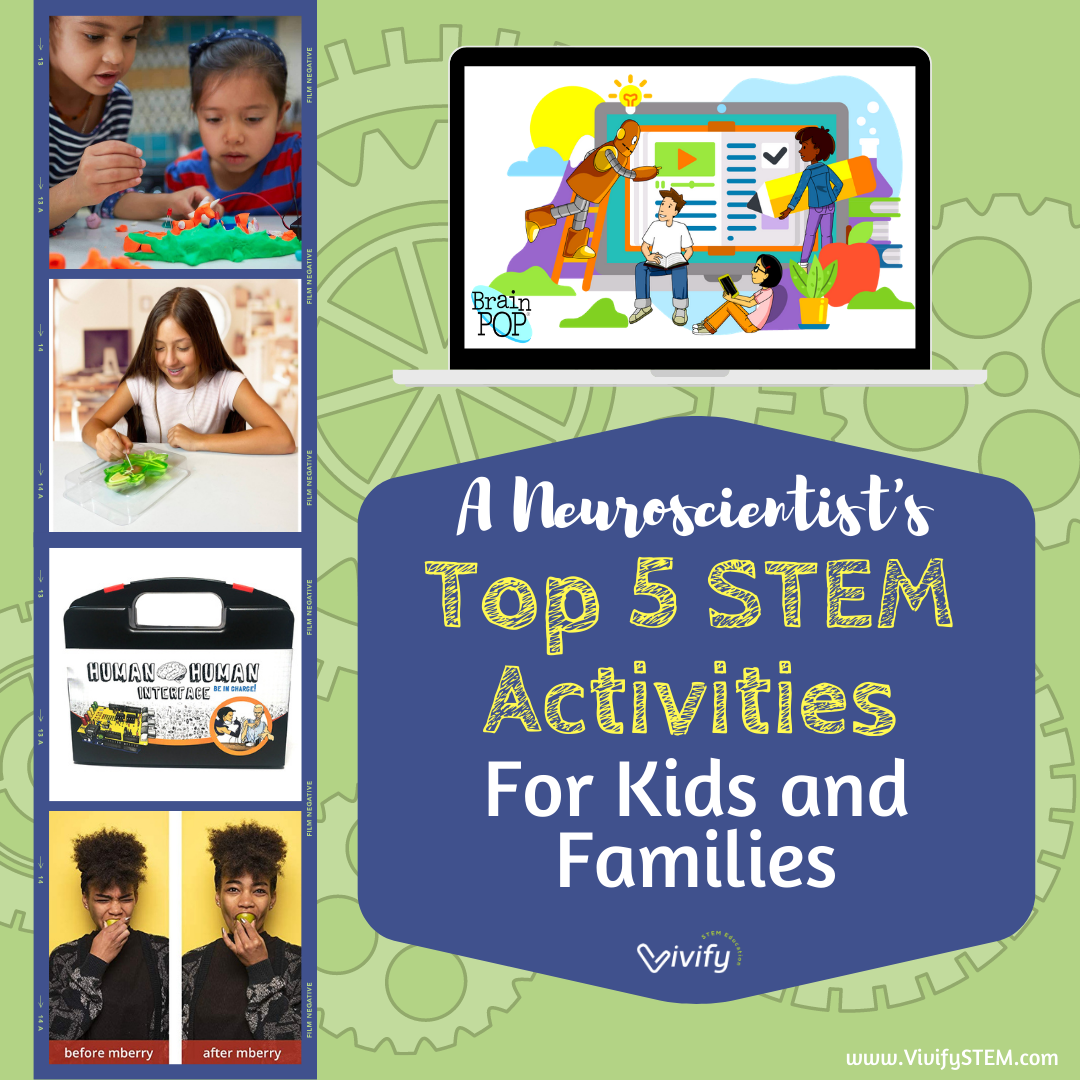A Neuroscientist’s Top 5 STEM Activities for Kids and Families!
Originally Posted: March 29, 2021
Updated: April 2024
Contribution by guest blogger Maria Garza.
Do you have kids interested in life sciences? We asked Maria Garza, a graduate student in neurobiology at the University of Texas at San Antonio to share her favorite activities! Read on for some toys, apps, and games to delight your students followed by some Vivify STEM lessons!
Some background on our guest blogger: Maria works with animal models to study how molecular mechanisms in the brain impact behavior and cognition. As a scientist, wife, and mother, she hopes to encourage other women and girls interested in STEM. Maria is also the founder of Women In Neuroscience, a public platform where women share their experiences in neuroscience, in order to create an atmosphere of support.
Note: Vivify STEM LLC is a participant in the Amazon Services LLC Associates Program, an affiliate advertising program designed to provide a means for us to earn fees by linking to Amazon.com and affiliated sites. This post includes such affiliate links.
Activity 1: Frog Dissection
Frog dissection is a classic life science activity. This is typically an activity you do in high school or college, but check out this version with plastic tools safe for kids over 6 years old!
According to the website: The kit is made out of gelatin-like material that is absolutely safe for children. The Dissect-It Frog gives the realistic experience of a frog dissection without the use of a real frog!
Best part? It’s only $13!
Activity 2: Backyard Brains
If you have a bigger budget, Backyard Brains has very sophisticated and fun kits for budding neuroscientists! Their most popular package is the “Human-Human Interface” which shows how electrical impulses from the brain can be channeled from one person to another allowing one person’s brain to control another person’s arm! But if you don’t want to spend the money, just watch the free videos on their site!
From the Backyard Brains website:
Have you ever dreamt of controlling the people around you? Family, friends, co-workers, even total strangers? Well now that power is yours thanks to the cutting edge of neuroscience and biotechnology, the Backyard Brains Human-Human Interface. With our electrophysiology setup, you will learn exciting neuroscience concepts first-hand as your brain sends an electrical impulse to your arm's muscles, telling them to move, and when your muscles move, this generates an even larger electrical signal. You'll take that electricity, then further amplify it and inject it into the nerves controlling another person's arm.
Activity 3: Circuit Building
For kids fascinated by electricity, Amazon has a large variety of circuit building kits for beginners. The Electro Dough kit pictured is suitable for kids from ages 4-10 and includes LED lights, buzzers, pop-out story cards, and access to more 500 hours’ worth of additional projects you can do with the circuits. While playing with this kit, your kids will gain beginner skills that apply to many fields including computer sciences, engineering, and neuroscience! (Price ~ $25)
NOTE: As of April 20, 2024, this kit seems to no longer be available. Another viable option is the ~$20 Squishy Circuits Dough Kit.
Activity 4: BrainPOP
If you just want to explore a cool, kid-friendly STEM website, check out BrainPOP. They have loads of content separated by subject and kid age. Their material includes informative videos, games, quizzes, and activities related to the topic. This website is an awesome tool for STEM supplementary education but also if you want to just have some fun exploring topics with your kids.
Activity 5: Trick your brain!
Amazon sells mBerry tablets (~$17) which contain a protein (miraculin) that binds to sweet taste receptors in your tongue, making anything you eat within a half-hour taste sweet! Amaze your kids and teach them about proteins and membrane receptors by giving these mBerry tablets a try! Here is the link to a story explaining how they work.
More Life Science Activities!
Want to bring more life science activities into your classroom? Check out these activities.
Activity 1: Strawberry DNA
Have you done the classic strawberry DNA experiment? Check out a video of this experiment with Natasha’s daughter Remi!
Here are some fun facts:
🍓 Strawberries have eight copies of each chromosome inside each cell, unlike humans which have 2 copies, so there is a lot of DNA available to extract.
🍓 Strawberry DNA looks similar to human DNA. All cell-based life on Earth has the same structure, a double-helix shaped molecule that forms into chromosomes within the cells.
🍓 Extracted DNA can be used for sequencing, fingerprinting, and cloning.
Activity 2: Heart Rate Math
How does your heart respond to exercise? Have students measure their resting heart rate and then calculate the increase in beats per minute after various activities such as jumping jacks or running in place.
Click here for Vivify’s lesson on Heart Rate Math that includes connections to sports medicine.
Activity 3: Biomes and Habitats Engineering Design Challenge
Add engineering to your life science units!
In this lesson, your students are terrestrial ecologists working to investigate and conserve animal habitats. They must first build a landscape of a biome (temperate forest, rainforest, freshwater, ocean, grasslands, desert, tundra, or taiga). Then they will use the engineering design process to solve a problem from one of the 64 included challenge cards. Can they make a trap to catch poachers? Can they help an okapi reach its food, or build a shelter to protect an animal from its predator? There is much to learn about biomes and animal habitats while constructing design solutions!







